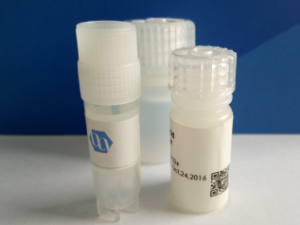$ 550.0
Quantity: 10 MG
In stock
Description
Product name: Antimicrobial peptide FALL-39
Catalog#: 1301002
Organism: human
Synonyms: FALL-39,Cathelicidin,hCAP-18,CAP-18,cationic antimicrobial protein,cationic antimicrobial peptide,
Sequence: FALLGDFFRKSKEKIGKEFKRIVQRIKDFLRNLVPRTES
Modifications:
M.W: 4711.52
M.F.: C217H354N62O55
Purity: 95% by HPLC
Counter ion: Trifluoacetate
Format: Lyophilized powder
Description: The peptide antibiotic PR-39 was originally isolated from the upper part of pig intestine. It has antibacterial activity against Gram negative bacteria at concentrations comparable with tetracycline. Studies of the mechanism of action showed that PR-39 inhibits both DNA and protein synthesis. Recently, PR-39 was found in wound fluid and was shown to have inductive activity on matrix components as part of the wound repair process. We have now sequenced the complete gene and possible mediators of its expression will be discussed. Our attempts to characterize the human counterpart of PR-39 by probing for the well conserved prepro-part led to a different peptide antibiotic. A clone containing the coding information for this new peptide was isolated from a human bone marrow cDNA library. The putative human peptide antibiotic was designated FALL-39 after the first four residues and the total number of residues. All human peptide antibiotics previously isolated (or predicted) belong to the defensin family with three disulfide bridges, while FALL-39 lacks cysteine. The clone for the prepro-FALL-39 encodes a cathelin-like precursor protein with 170 amino acid residues. We have postulated a dibasic processing site for the mature FALL-39 and chemically synthesized the peptide. In the presence of the basal medium E, synthetic FALL-39 was highly active against Escherichia coli D21 and Bacillus megaterium Bm11. Residues 13-34 in FALL-39 can be predicted to form a perfect amphipatic helix and CD spectra showed that medium E induced 30% helix formation in FALL-39. By Northern blot analyses the transcript was located in bone marrow and testis. The structure of the gene and the chromosomal location is under investigation.
Uniprot ID: P49913
Usage: For Scientific Research Use Only, Not for Human Use.

